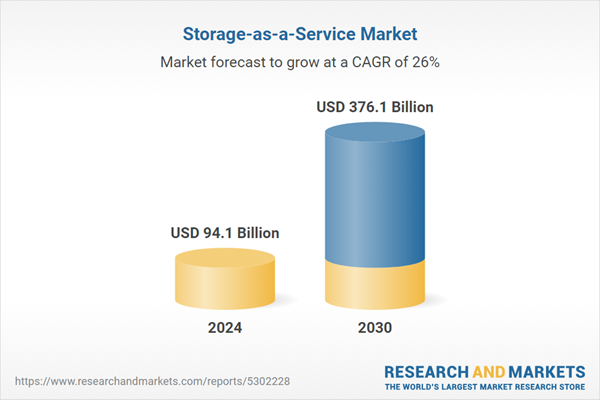Global Storage-as-a-Service Market - Key Trends and Drivers Summarized
Why Is Storage-as-a-Service Reshaping Data Management for Businesses?
Storage-as-a-Service (STaaS) is rapidly becoming a game-changing solution in how organizations manage their ever-growing data needs. But what exactly makes STaaS so transformative? Storage-as-a-Service allows businesses to store and manage their data in the cloud or on a hybrid platform, outsourcing the infrastructure and operational costs typically associated with maintaining physical storage systems. In a world where data volumes are increasing exponentially due to digital transformation, IoT devices, and cloud computing, STaaS provides a flexible, scalable, and cost-effective solution. Unlike traditional on-premises storage systems, which require significant capital investment in hardware and ongoing maintenance, STaaS operates on a subscription model, where companies pay only for the storage they use. This model not only reduces upfront costs but also provides businesses with the ability to scale their storage needs up or down based on real-time requirements. Furthermore, the service includes data management features such as automatic backups, disaster recovery, and data replication, ensuring that critical information remains secure and accessible without the complexity of managing physical infrastructure.How Does Storage-as-a-Service Improve Scalability and Data Security?
One of the key advantages of Storage-as-a-Service is its ability to provide businesses with highly scalable and secure data storage options, helping organizations cope with growing data demands without worrying about physical capacity limitations. Scalability is a cornerstone of the STaaS model, enabling companies to expand their storage capacity as their data needs increase, without requiring additional hardware purchases or infrastructure upgrades. Whether an organization needs to store terabytes or petabytes of data, STaaS providers offer elastic solutions that can be adjusted instantly to meet fluctuating demands. This flexibility is especially critical for industries with unpredictable data growth patterns, such as media, finance, and healthcare, where the ability to manage large volumes of data efficiently can directly impact business outcomes. In terms of security, STaaS providers often offer a suite of advanced security measures, including encryption, access control, and multi-factor authentication, to protect sensitive data both in transit and at rest. Data stored in the cloud is also backed by redundant systems and distributed across multiple locations, ensuring that even in the event of a hardware failure or natural disaster, information remains safe and recoverable. Additionally, many STaaS providers comply with industry-specific regulations such as HIPAA, GDPR, and PCI DSS, making them suitable for sectors that handle sensitive information and require strict compliance standards. These built-in security features relieve businesses of the need to invest in expensive cybersecurity solutions, allowing them to focus on their core operations.Who Stands to Gain the Most From Storage-as-a-Service Across Different Sectors?
Storage-as-a-Service offers critical advantages across a wide array of industries, with organizations of all sizes benefiting from its flexible and cost-effective approach to data management. In the financial services sector, for instance, institutions generate and store massive amounts of data related to transactions, customer information, and regulatory reporting. STaaS helps financial companies meet these demands by providing scalable storage solutions that can grow in step with their data requirements, while also ensuring compliance with stringent financial regulations. In healthcare, the rise of electronic health records (EHRs) and medical imaging has led to a surge in data volumes. With Storage-as-a-Service, healthcare providers can securely store and manage patient data while ensuring that it is easily accessible for medical professionals, improving patient care and operational efficiency. The media and entertainment industry also benefits greatly from STaaS, particularly as the demand for high-resolution video content and large-scale digital libraries grows. Companies can store and distribute enormous volumes of content without worrying about physical storage constraints. Startups and small to medium-sized enterprises (SMEs) are another major beneficiary of STaaS, as it allows them to access enterprise-grade storage solutions without the significant investment in infrastructure typically required. These businesses can start small and scale their storage as they grow, helping them remain agile in competitive markets. Educational institutions, research organizations, and government agencies also stand to gain from STaaS, as they deal with vast amounts of data that must be securely stored and easily retrieved, whether for research, archiving, or public access purposes.What Factors Are Driving the Rapid Growth of the Storage-as-a-Service Market?
The growth in the Storage-as-a-Service market is driven by several factors, reflecting both technological advancements and changing business needs. One of the most significant drivers is the exponential growth of data worldwide, fueled by the rise of cloud computing, big data analytics, artificial intelligence (AI), and IoT devices. As organizations generate more data than ever before, traditional on-premises storage solutions are becoming increasingly inadequate, pushing companies toward more flexible and scalable options like STaaS. The shift toward digital transformation across industries is another key driver, as businesses are looking to move away from legacy infrastructure and adopt cloud-based solutions that offer more agility and lower operational costs. Moreover, the increasing need for cost optimization is driving businesses to adopt STaaS, as the subscription-based model allows organizations to avoid the heavy capital expenses associated with purchasing and maintaining physical storage hardware. Instead, businesses can pay for storage on an as-needed basis, making STaaS a more budget-friendly option, particularly for small and mid-sized companies. Data security and regulatory compliance are also critical growth drivers, as businesses seek storage solutions that not only protect their data from cyber threats but also help them comply with industry-specific regulations. STaaS providers typically offer robust security features and comply with regulatory standards, giving businesses peace of mind. Lastly, the rise of hybrid cloud environments, which combine on-premises infrastructure with cloud storage, has further propelled the STaaS market. Hybrid solutions allow businesses to maintain control over their most sensitive data while taking advantage of the scalability and flexibility of the cloud, creating a balanced approach to data management. As more organizations seek to streamline their data storage operations and future-proof their infrastructure, the demand for Storage-as-a-Service is expected to continue growing at a rapid pace.Report Scope
The report analyzes the Storage-as-a-Service market, presented in terms of market value (US$ Thousand). The analysis covers the key segments and geographic regions outlined below.- Segments: Technology (Stand-Alone & Platform-Attached Storage, Cloud Archiving, Cloud Backup).
- Geographic Regions/Countries:World; United States; Canada; Japan; China; Europe (France; Germany; Italy; United Kingdom; Spain; Russia; and Rest of Europe); Asia-Pacific (Australia; India; South Korea; and Rest of Asia-Pacific); Latin America (Argentina; Brazil; Mexico; and Rest of Latin America); Middle East (Iran; Israel; Saudi Arabia; United Arab Emirates; and Rest of Middle East); and Africa.
Key Insights:
- Market Growth: Understand the significant growth trajectory of the Stand-Alone & Platform-Attached Storage segment, which is expected to reach US$143.3 Billion by 2030 with a CAGR of a 23.8%. The Cloud Archiving segment is also set to grow at 28.4% CAGR over the analysis period.
- Regional Analysis: Gain insights into the U.S. market, valued at $23.5 Billion in 2024, and China, forecasted to grow at an impressive 32.5% CAGR to reach $106.3 Billion by 2030. Discover growth trends in other key regions, including Japan, Canada, Germany, and the Asia-Pacific.
Why You Should Buy This Report:
- Detailed Market Analysis: Access a thorough analysis of the Global Storage-as-a-Service Market, covering all major geographic regions and market segments.
- Competitive Insights: Get an overview of the competitive landscape, including the market presence of major players across different geographies.
- Future Trends and Drivers: Understand the key trends and drivers shaping the future of the Global Storage-as-a-Service Market.
- Actionable Insights: Benefit from actionable insights that can help you identify new revenue opportunities and make strategic business decisions.
Key Questions Answered:
- How is the Global Storage-as-a-Service Market expected to evolve by 2030?
- What are the main drivers and restraints affecting the market?
- Which market segments will grow the most over the forecast period?
- How will market shares for different regions and segments change by 2030?
- Who are the leading players in the market, and what are their prospects?
Report Features:
- Comprehensive Market Data: Independent analysis of annual sales and market forecasts in US$ Million from 2024 to 2030.
- In-Depth Regional Analysis: Detailed insights into key markets, including the U.S., China, Japan, Canada, Europe, Asia-Pacific, Latin America, Middle East, and Africa.
- Company Profiles: Coverage of players such as Alphabet, Amazon.com, AT&T, AWS, Cloudian and more.
- Complimentary Updates: Receive free report updates for one year to keep you informed of the latest market developments.
Some of the 34 companies featured in this Storage-as-a-Service market report include:
- Alphabet
- Amazon.com
- AT&T
- AWS
- Cloudian
- Dell Technologies
- Hewlett Packard Enterprise
- Hitachi Vantara
- HPE
This edition integrates the latest global trade and economic shifts into comprehensive market analysis. Key updates include:
- Tariff and Trade Impact: Insights into global tariff negotiations across 180+ countries, with analysis of supply chain turbulence, sourcing disruptions, and geographic realignment. Special focus on 2025 as a pivotal year for trade tensions, including updated perspectives on the Trump-era tariffs.
- Adjusted Forecasts and Analytics: Revised global and regional market forecasts through 2030, incorporating tariff effects, economic uncertainty, and structural changes in globalization. Includes historical analysis from 2015 to 2023.
- Strategic Market Dynamics: Evaluation of revised market prospects, regional outlooks, and key economic indicators such as population and urbanization trends.
- Innovation & Technology Trends: Latest developments in product and process innovation, emerging technologies, and key industry drivers shaping the competitive landscape.
- Competitive Intelligence: Updated global market share estimates for 2025, competitive positioning of major players (Strong/Active/Niche/Trivial), and refined focus on leading global brands and core players.
- Expert Insight & Commentary: Strategic analysis from economists, trade experts, and domain specialists to contextualize market shifts and identify emerging opportunities.
Table of Contents
Companies Mentioned (Partial List)
A selection of companies mentioned in this report includes, but is not limited to:
- Alphabet
- Amazon.com
- AT&T
- AWS
- Cloudian
- Dell Technologies
- Hewlett Packard Enterprise
- Hitachi Vantara
- HPE
Table Information
| Report Attribute | Details |
|---|---|
| No. of Pages | 175 |
| Published | January 2026 |
| Forecast Period | 2024 - 2030 |
| Estimated Market Value ( USD | $ 94.1 Billion |
| Forecasted Market Value ( USD | $ 376.1 Billion |
| Compound Annual Growth Rate | 26.0% |
| Regions Covered | Global |









